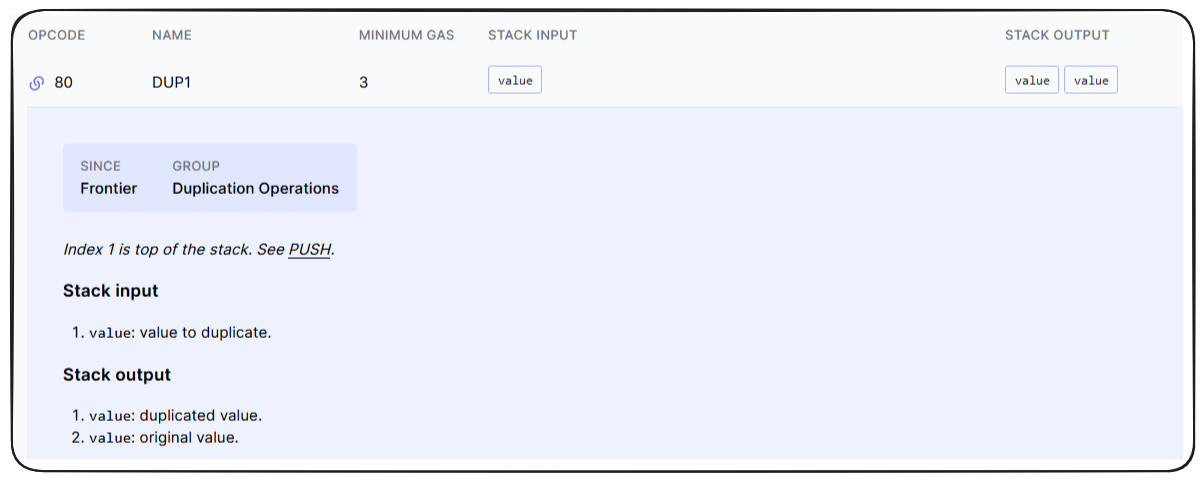5/5
_Follow along with this video:_ --- ### Duplicating Stack Items At this point, what we've written will handle calldata which pertains to the updateHorseNumber function selector. We need to ask ourselves - _"How are we going to handle if a different selector is passed with our received `calldata`?"_ We could do another comparison, but if we haven't jumped anywhere, our stack is empty. We would have to again derive what the calldata's function selector is from scratch, implementing another round of `calldataload` and `shr`. There may be a better way... ```js #define macro MAIN() = takes(0) returns(0){ 0x00 calldataload 0xe0 shr // [function_selector] 0xcdfead2e // [0xcdfead2e, function_selector] eq // [true/false] updateJump // [updateHorseNumberProgramCounter, true/false] jumpi // [] updateJump: SET_NUMBER_OF_HORSES() } #define macro SET_NUMBER_OF_HORSES() = takes(0) returns(0){} ``` An opcode is available to us which will help us achieve a cleaner and more gas efficient path to our goal, `DUP1`  `DUP1` simply takes the top item of the stack, copies it and adds both items back to the stack. By executing this opcode directly after the first time we accessed the `calldata`'s `function selector`, it would keep a copy of this selector for us to access, on the bottom of our stack. How does this look in our code? ```js #define macro MAIN() = takes(0) returns(0){ 0x00 calldataload 0xe0 shr // [function_selector] dup1 // [function_selector, function selector] 0xcdfead2e // [0xcdfead2e, function_selector, function selector] eq // [true/false, function selector] updateJump // [updateHorseNumberProgramCounter, true/false, function selector] jumpi // [function selector] updateJump: SET_NUMBER_OF_HORSES() } #define macro SET_NUMBER_OF_HORSES() = takes(0) returns(0){} ``` I've updated the comments in the code above to visualize how our duplicated `function selector` is carried through each step of execution. We see resultingly that, if we don't jump to `updateJump`, our stack still retains the `function selector` that was passed with the received `calldata`. Now that we have access to this function selector again, we're prepared to start handling calls to `readNumberOfHorses()`. Let's look at that in the next lesson!
Follow along with this video:
Duplicating Stack Items
At this point, what we've written will handle calldata which pertains to the updateHorseNumber function selector. We need to ask ourselves - "How are we going to handle if a different selector is passed with our received calldata?"
We could do another comparison, but if we haven't jumped anywhere, our stack is empty. We would have to again derive what the calldata's function selector is from scratch, implementing another round of calldataload and shr. There may be a better way...
An opcode is available to us which will help us achieve a cleaner and more gas efficient path to our goal, DUP1

DUP1 simply takes the top item of the stack, copies it and adds both items back to the stack. By executing this opcode directly after the first time we accessed the calldata's function selector, it would keep a copy of this selector for us to access, on the bottom of our stack. How does this look in our code?
I've updated the comments in the code above to visualize how our duplicated function selector is carried through each step of execution. We see resultingly that, if we don't jump to updateJump, our stack still retains the function selector that was passed with the received calldata.
Now that we have access to this function selector again, we're prepared to start handling calls to readNumberOfHorses(). Let's look at that in the next lesson!
DUP1
A comprehensive guide to the DUP1 opcode in Huff. Learn how the DUP1 opcode duplicates the top item on the stack and why it's a valuable tool for function selector checking.
Previous lesson
Previous
Next lesson
Next
Give us feedback
Course Overview
About the course
What you'll learn
Assembly
Writing smart contracts using Huff and Yul
Ethereum Virtual Machine OPCodes
Formal verification testing
Smart contract invariant testing
Halmos, Certora, Kontrol
Course Description
Who is this course for?
- Smart contract security researchers
- Advanced Smart contract engineers
- Chief Security Officiers
- Security professionals
Potential Careers
Security researcher
$49,999 - $120,000 (avg. salary)
Smart Contract Auditor
$100,000 - $200,000 (avg. salary)
Meet your instructors
Guest lecturers:
Last updated on August 11, 2025
Duration: 30min
Duration: 4h 38min
Duration: 3h 57min
Duration: 1h 56min
Course Overview
About the course
What you'll learn
Assembly
Writing smart contracts using Huff and Yul
Ethereum Virtual Machine OPCodes
Formal verification testing
Smart contract invariant testing
Halmos, Certora, Kontrol
Course Description
Who is this course for?
- Smart contract security researchers
- Advanced Smart contract engineers
- Chief Security Officiers
- Security professionals
Potential Careers
Security researcher
$49,999 - $120,000 (avg. salary)
Smart Contract Auditor
$100,000 - $200,000 (avg. salary)
Meet your instructors
Guest lecturers:
Last updated on August 11, 2025
